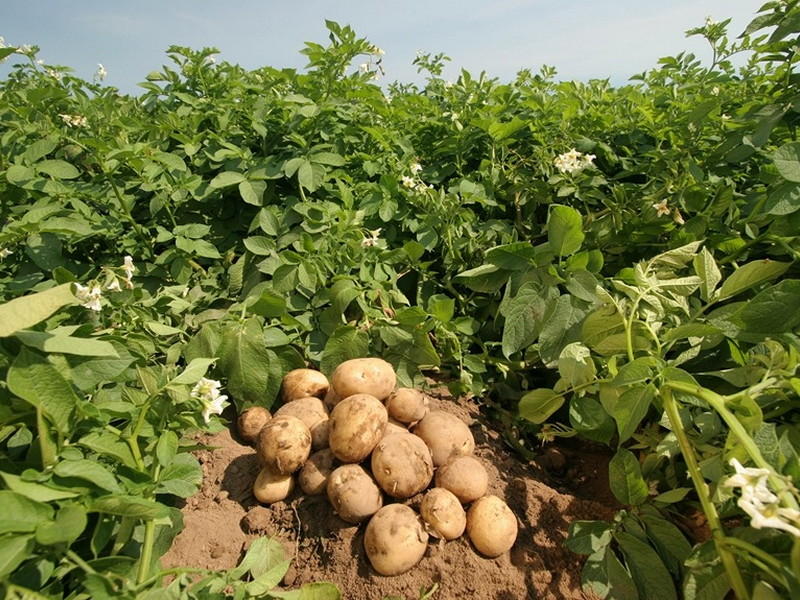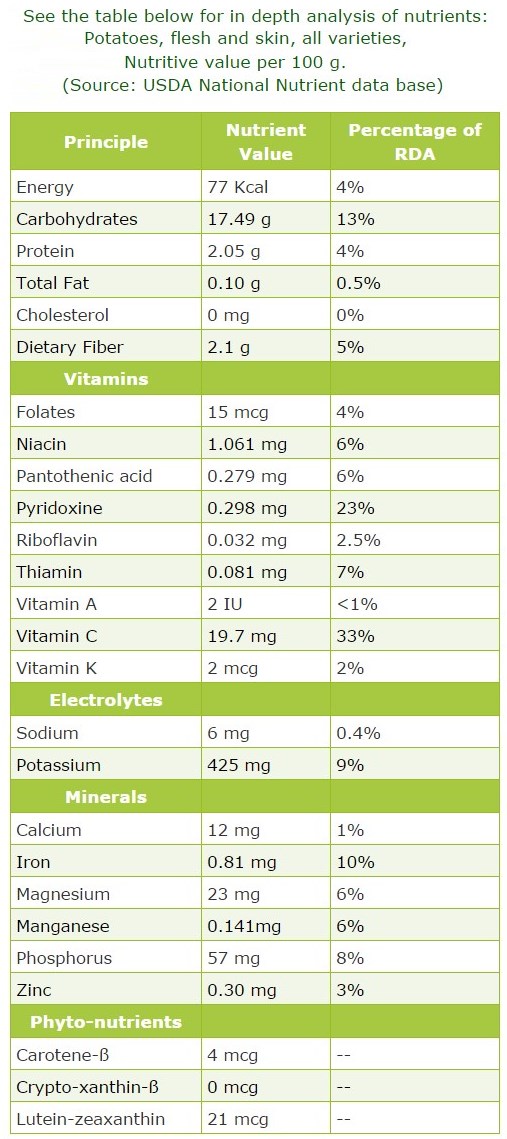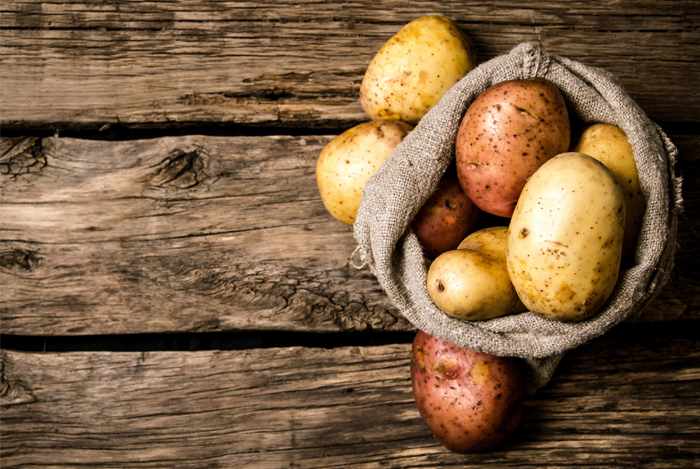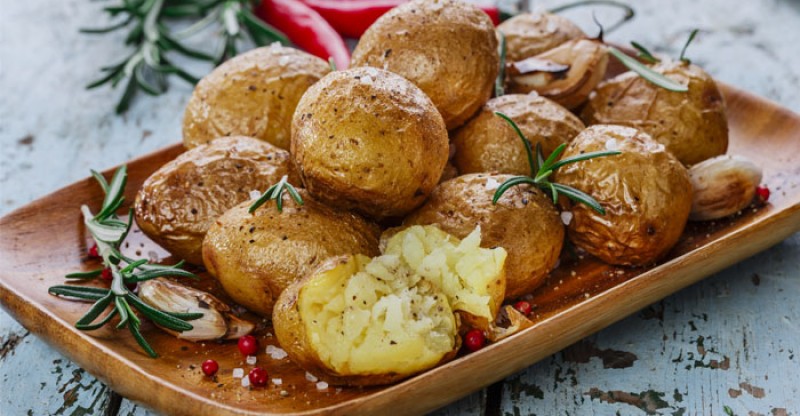22 Evidence-Based Benefits of Potatoes
Potatoes are one of the most common, popular vegetables — both in the United States and worldwide.
Thanks to potatoes, we have French fries, which is one of the human race’s favorite dishes.
Although this dish is not as healthy as it should be, many other dishes with potatoes as ingredients are much healthier.
That being said, it is a misconception that potatoes are not very rich in nutrients.
In fact, potatoes have been labeled as one of the planet’s essential food sources.
Plus, they contain a wealth of health benefits, such as the ability to improve digestion, prevent cancer, and boost heart health.
We’ll discuss them later on.
History
The potato comes from the perennial Solanum tuberosum.
It’s the world’s fourth largest food crop, just behind wheat, rice, and maize.
The first cultivators of potatoes were the Incans in Peru—from about 8,000 BC to 5,000 BC.
Spanish Conquistadors conquered Peru in 1536, and they soon discovered the flavors of potatoes and took them back to Europe.
By the end of the 16th century, families of Basque sailors started cultivating potatoes along the Biscay coast of northern Spain.
Thanks to Sir Walter Raleigh, potatoes were introduced to Ireland in 1589 — on 40,000 acres of land near the city of Cork.
It took nearly four decades for the potato to spread across the rest of Europe.
Eventually, European agriculturalists realized that potatoes were much easier to grow and cultivate than other staple crops, such as oats and wheat.
Most importantly, potatoes soon became known for their nutritional profile — because they contain most of the vitamins needed for sustenance.
What’s more, each acre of cultivated land provided enough potatoes to feed about 10 people.
In the 1840s, a major outbreak of potato blight occurred.
This plant disease swept through Europe, wiping out the potato crop in many countries.
By this time, the potato was the primary food source of the Irish working class.
So when the blight reached Ireland, this staple disappeared.
This famine left many poverty-stricken families in desperation.
Over the course of the Potato Famine, almost one million people died because of disease or starvation.
Another million fled the country, mostly for the United States and Canada.

How Potatoes Grow
Potato plants grow about 12 to 18 inches in height and bear numerous tubers underground.
These tubers are usually round or oval in shape but vary widely in size.
Internally, the flesh features either a reddish-brown, rosy, or bright cream, color — depending on the variety.
It has a moist, crunchy texture. Once baked, it becomes soft and has a special buttery flavor.
Varieties
There are more than 600 varieties of potatoes sold throughout the United States.
Each of these varieties fits into 1 of 7 categories: russet, white, red, yellow, blue/purple, fingerling, and petite.
Below is a list of the characteristics and cooking recommendations for each type.
Russet Potatoes
These vegetables are perfect for light, fluffy mashed potatoes.
They’re also crisp and golden brown after frying, and they’re the ideal choice for baking.
The fluffy texture and delicate flavor of baked russets go well with all kinds of toppings — from spicy, bold Mediterranean flavors to the traditional sour cream and chives.
To make roasted fries, try cutting them into wedges or planks.
White Potatoes
These potatoes retain their shape well after the cooking process.
Grilling white potatoes brings out a more full-bodied flavor.
Moreover, whites are good for creating signature potato salads, such as ranch dressing, a chopped crumble made of eggs and bacon, or Caesar dressing and grated Parmesan.
Red Potatoes
Because of their waxy texture, the flesh of red potatoes stays firm throughout the cooking process, including roasting and cooking in a stew.
Their thin yet vibrant red skin adds appealing texture to salads and side dishes.
Red potatoes are frequently used to make tender yet firm potato salad or add pizzazz to stews and soups.
They can also be served mashed or baked.
Round red potatoes are often referred to as “new potatoes.”
Actually, the term is used for any type of potato that’s harvested prior to reaching maturity.
Yellow Potatoes
After being grilled, yellow potatoes offer a crispy skin that enhances its density — creating a slightly sweet, caramelized flavor.
The golden color and creamy texture of yellow potatoes mean that you can use less (or no) butter for healthier, lighter dishes.
Simmer yellow potatoes without cooking them fully.
Next drain, chill and cut them into flat disks.
Brown them in clarified butter or oil.
Then serve them as an appetizer or side dish, topped with chives and sour cream or other garnishes.
Blue/Purple Potatoes
Most blue/purple potatoes have firm, moist flesh that holds its shape — while adding vibrant, rich color and luscious flavor to salads.
The purple color is best retained by microwaving, but baking and steaming are also great ways to cook blue/purple potatoes.
Having a mild, nutty taste, blue/purple potatoes go really well with the flavors of green salad.
You can also make a patriotic dish by combining red, white, and blue potatoes in salads or roasted medleys.
Fingerling Potatoes
The shape and color of fingerlings are a welcome visual addition to any dish.
By roasting and pan-frying them, you can enhance their robust taste and showcase their wonderful, nutty, buttery flavors.
Split fingerlings lengthwise and oven-roast them as a side dish or a small-plate alternative to fries.
And add a dipping sauce, such as romesco, ketchup, or sriracha mayo.
Petite Potatoes
Petites make a great substitute for pasta and also add nutritional value.
Roast a combination of colors for an eye-catching side dish.
Since they boast a concentrated flavor and quicker cooking time, petites are a good choice for potato salads.
To make colorful, delicious, fun roasted potatoes, add olive oil, rosemary, and salt and pepper.
They save you prep time because they can be prepared and served whole — without slicing or chopping.
Interesting Facts
The potato may not look special, but it has a long, esteemed history that spans all seven continents.
- On average, every human being eats 33 kg of potatoes each year. According to the statistics, Australians are the biggest potato lovers, eating 60 kg per person!
- In 1995, the potato became the very first vegetable to be grown in space. Specifically, the potato seeds were germinated on the space shuttle Columbia.
- Humans can apparently live off a diet of just potatoes and butter or milk. Dairy products contain vitamin A and D, the only essential vitamins that this vegetable doesn’t contain.
- The world’s biggest potato weighed a hefty 3.76 kg. It was grown by Peter Glazebrook in 2010.
- China is currently the leading producer of potatoes worldwide.
- Potatoes contain a poisonous compound called solanine, which can reach levels that induce a toxic reaction in green potatoes. In rare cases, it can cause diarrhea, headaches, and cramps. And in isolated instances, it can even induce a coma and lead to death.
- For various reasons, the potato was not popular in Europe for a long time. Some the reasons are that it wasn’t mentioned in the Bible, and it was thought to cause diseases such as leprosy.
- Thomas Jefferson made french fries popular in America when he served them at a White House dinner.
- The English word “potato” is derived from the Spanish word “batata.”
- Potato cultivation is rapidly changing all around the world. Up to the early 1990s, the great majority of potatoes were grown in North America, Western Europe, and the former Soviet Union. However, Asia, Africa, and South America have experienced huge increases in production and consumption since then. Production in these areas climbed from 30 million tons (in the 1960s) to 165 million tons (in 2007).
Nutritional Facts

Another name for potatoes could easily be “the nutritional powerhouse.”
Potatoes are rich in numerous nutrients, and they’re certainly a healthy choice — due to the dozens of vitamins and minerals they contain.
Here are some important nutritional facts about potatoes:
- A medium-sized potato contains up to 46% of the daily recommended intake of vitamin C. This vitamin is important because it acts as an antioxidant, eliminates or stabilizes free radicals, gives assistance in the production of collagen, and aids in the absorption of iron.
- A medium-sized potato contains up to 18% of your daily intake of potassium. That’s the same amount that you get in a serving of broccoli or bananas. Potassium plays an important role in helping reduce blood pressure, and it’s an essential micronutrient.
- Potatoes have significant quantities of other valuable micronutrients, such as iron, folate, niacin, thiamin, and zinc.
- Unskinned potatoes (e.g., new potatoes and baked potatoes) can contain up to 7g of dietary fiber — making it one of the best options in the produce aisle. A skinned, medium-sized potato still contains 2 g of dietary fiber.
- Potatoes have high amounts of resistant starch, which boosts colon health — due to its prebiotic properties.
- Potatoes are naturally free of sodium and fat.
- Potatoes are also gluten-free, which makes them an important source of carbohydrates for patients with gluten sensitivities or Celiac disease.
22 Science-Backed Health Benefits of Potatoes
Potatoes are a very popular food source, but most people eat them the wrong way — in the form of greasy french fries or potato chips.
To make things worse, even baked potatoes are typically packed with fats, such as butter, melted cheese, sour cream, and bacon bits.
So it can be a challenge to lose weight if you’re eating potatoes in these ways.
In fact, potatoes can contribute to the risk of having a heart attack.
On the other hand, if prepared without extra fat and deep-frying, even baked potatoes can be exceptionally healthy foods.
They’re low in calories and rich in fiber, and they offer significant protection against cardiovascular disease and cancer.
According to our food ranking system, potatoes are a very good source of vitamin B6, potassium, iron, copper, manganese, vitamin C, phosphorus, dietary fiber, niacin, and pantothenic acid.
Potatoes also contain a variety of phytonutrients that have antioxidant properties.
Among these health-promoting compounds are flavonoids, carotenoids, and caffeic acid — as well as unique tuber storage proteins (such as patatin, which prevents the damage of free radicals).
Potatoes Can Help You Gain Weight
Other health-related articles usually list weight loss as one of the best health benefits of a vegetable.
However, this list contains the complete opposite.
To be precise, potatoes are one of the best food sources for gaining weight in a healthy, progressive way.
Potatoes primarily consist of carbohydrates and contain very low amounts of protein.
Potatoes are ideal for extremely thin people, who’re desperately trying to put on weight.
According to a Human Nutrition Program study in 1991, food sources rich in fat are more likely to contribute to human obesity syndromes, as opposed to foods rich in carbohydrates (1).
And remember, potatoes contain vitamin C and B-complex, which play an important role in the proper absorption of carbohydrates.
It’s one of the main reasons why potatoes make up a large part of the diet of sumo wrestlers and many other athletes; in order to compete, they require large reserves of energy to burn off.
Potatoes Improve Digestion
Since potatoes predominantly contain carbohydrates, they easily facilitate digestion.
The American Society for Clinical Nutrition conducted a study in 1994, which suggests that the in vitro rate of starch digestion is a key determinant of metabolic responses in most products (2).
This property adds to their nutritional value, especially when ingested by infants (who cannot digest hard food but need the energy).
However, overeating potatoes on a regular basis may cause acidity over time.
Potatoes are also high in fiber, especially when they’re raw and cold.
This trait stimulates peristaltic motion and increased secretion of gastric juices, which boosts digestion, promotes regularity for a healthy digestive tract and protects the body from various conditions (including colorectal cancer) (3).
Potatoes Offer Skin Care
Vitamins (such as C and B-complex) and minerals (such as potassium, magnesium, zinc, and phosphorus) are essential for skin health.
A 2001 study about skincare found that therapeutic vitamins (such as vitamins A and D) and antioxidant vitamins (such as C, E, and Q) play an important role in skincare.
Their benefits range from the inhibition of skin conditions (such as psoriasis and acne) to protect against environmental conditions (caused by the sun, pollution, and smoke).
On top of that, vitamin C also promotes the ability of collagen to smooth wrinkles and improve overall skin texture (4).
And when mixed with honey, the pulp obtained from crushed raw potatoes can work well on the face and skin.
In fact, it’s been proven to help cure pimples and other blemishes.
Again, if applied externally on burns, this pulp provides faster relief and healing.
Smashed potatoes (including the water in which potatoes have been washed) are beneficial to softening and cleaning skin (especially around the elbows and the backs of the hands).

Potatoes Prevent Scurvy
First things first – what is scurvy?
It’s a disease caused by a vitamin-C deficiency, and it’s characterized by swollen, bleeding gums and the reopening of previously healed wounds.
Until the end of the 18th century, this disease was very common in poorly nourished sailors.
Due to potatoes’ rich content of vitamin C, they can help in preventing this disease.
The Journal of Agricultural & Food Chemistry published a study in 2007, which suggested that Andean potato cultivars should be exploited — for the development of potato varieties with enhanced health and nutritional benefits.
As a result, scurvy will be a thing of the past (5).
Despite scurvy’s elimination from most countries with ready access to vitamin C, it remains present in certain parts of the world.
Therefore, the increased, prolific presence of potatoes around the world helps treat this problem.
Potatoes Relieve the Symptoms of Rheumatism
Due to their calcium and magnesium content, potatoes help provide relief from rheumatism.
In 2007, a Food and Agriculture Organization of the United Nations study investigated the potato’s suppressive effects on type II collagen-induced arthritis (CIA).
Mice were given potato extracts for 49 days.
The production of CIA-related rheumatism was examined, and the results suggested that potato extracts are efficacious against CIA in mice (6).
Moreover, water obtained from boiling potatoes can relieve the inflammation and pain of rheumatism.
However, its high carbohydrate and starch content contributes to increasing body weight, which may have adverse effects on rheumatic people.
It’s a delicate balance, so you should apply this approach without actually eating the potato.
Potatoes Contain Choline
Technically a “vitamin-like factor,” choline is an important, versatile nutrient found in potatoes.
The body can produce small amounts of choline, but you should also get some of it from your diet.
Choline is an essential part of all body tissues.
It helps with sleep, learning, memory, and muscle movement.
Moreover, it helps in the transmission of nerve impulses, reduces chronic inflammation, and assists in the absorption of fat.
Potatoes Prevent Inflammation
Potatoes are very effective in reducing inflammation (both internal and external).
Food and Agricultural Immunology published a study in 2005.
Its goal was to evaluate potato extracts and their antinociceptive and anti-inflammatory activities in mice.
The results suggest that potato extracts are effective in relieving inflammatory pain and developing new agents for treating inflammatory diseases (8).
Potatoes are soft and easily digested, and as already mentioned, they have great amounts of vitamin C, potassium, and vitamin B6.
All of these factors relieve any inflammation of the intestines and digestive system.
There is a misconception about potatoes triggering arthritis flares.
However, according to the Arthritis Foundation, limited scientific evidence is at hand to support this hypothesis (9).
In fact, a 2011 study published in the Journal of Nutrition suggested that nightshade vegetables (including the potato) may actually help in reducing the symptoms of arthritis.
The study results suggest that inflammation and DNA in healthy adult males can be reduced by the consumption of pigmented potatoes.
This information enables people to have more nutritional choices when consuming potatoes (10).
People with mouth ulcers should also consume potatoes for their dietary properties.
And those who suffer from gout can use potatoes for their anti-inflammatory qualities.
However, weight gain exacerbates these conditions, so you should only incorporate a preset amount of potatoes into your diet.
Potatoes Prevent Cancer
Some potato varieties (particularly russets and reds) contain high amounts of flavonoid antioxidants and vitamin A (such as carotenes and zeaxanthin).
These ingredients provide protection against many types of cancer.
According to the Journal of Food Science, the antioxidant activity of potatoes was higher than carrots, onions, and bell peppers.
And the patatin present in potatoes exhibits strong antioxidant activity.
This activity was evenly distributed in potatoes — except in skin tissue, which had the strongest antioxidant activity and total phenolic content (11).
Also, Advances in Experimental Medicine and Biology presented a study that found that quercetin (which is present in potatoes) exhibits strong antioxidant activity.
In other words, it has anticancer and antitumor properties (12).
Moreover, potatoes contain folate, which plays an important role in DNA synthesis and repair.
Therefore, they prevent the formation of cancer cells from mutations in the DNA (13).
According to BMJ, fiber intake from fruits, vegetables, and whole grains has been associated with a reduced risk of colorectal cancer (14).
Finally, the high amounts of vitamin A and C contribute to the potatoes’ capacity to fight off cancer cells.
Hence, they protect your body from the devastating effects of cancer.
Potatoes are High in Potassium
Potassium is the predominant mineral in potatoes.
It’s concentrated in the potato skin.
The intake of potassium may have numerous benefits on human health (15).
According to a 2014 research conducted by Current Opinion in Lipidology, an increase in potassium intake decreases blood pressure, the incidence of hypertension, and mortality from cardiovascular disease (16).
Potatoes Reduce Blood Pressure
There are a number of reasons why you might suffer from high blood pressure.
Some of them include diabetes, indigestion, tension, food content, and nutrient balance.
Therefore, various treatments are necessary.
Fortunately, potatoes can alleviate multiple causes.
One of them is high blood pressure caused by tension, which can be relieved by potato consumption.
Potatoes are a promising source for the production of bioactive compounds.
And according to Food Chemistry, they have a beneficial impact on high blood pressure and cardiovascular health in general (17).
Due to the high amounts of vitamin C and fiber present in potatoes, they can also help with the symptoms of indigestion.
However, you should avoid them if your high blood pressure is the result of diabetes.
The fiber found in potatoes can help lower cholesterol and improve insulin function in the body by binding it with cholesterol in the blood.
There is a direct relationship between blood pressure and glucose levels, and insulin is thankfully capable of regulating it.
And remember, potatoes are a better source of potassium than the banana.
According to the Journal of Experimental Botany, potassium lowers blood pressure, since it functions as a vasodilator (18).
Scientists have also discovered that potatoes contain substances, including chlorogenic acid and kukoamines, which may promote lower blood pressure (19, 20).
According to the National Health and Nutrition Examination Survey, less than 2% of American adults meet the recommended daily intake of 4.7 g (21).
Also, potassium, magnesium, and calcium have been found to naturally reduce high blood pressure levels (22).
Potatoes Prevent Heart Disease
Aside from vitamins, minerals, and roughage, potatoes also contain compounds called carotenoids, such as lutein and zeaxanthin.
Carotenoids are critical to heart health and the function of other internal organs.
However, overconsumption of potatoes will raise glucose levels in the blood, which will put additional pressure on your heart, thereby causing obesity.
For that reason, this method of preventing heart disease is not recommended for diabetic or obese people (23).
Coupled with the potato’s lack of cholesterol, its content of fiber, vitamin C, vitamin B6, and potassium supports heart health.
Vitamin B6 plays a crucial role in the methylation process.
According to Harvard University, this process changes homocysteine into methionine.
Too much homocysteine can be harmful to blood vessel walls, and high levels of it have been associated with an increased risk of heart attack and stroke (24).
Potatoes contain considerable amounts of fiber, which helps reduce the total amount of cholesterol in the blood, thus reducing the risk of heart disease.
In a 2012 study published in Today’s Dietitian, individuals who consumed 4 g of potassium per day had a 49% lower risk of death from ischemic heart disease than individuals who consumed 1 g per day (25).
Potatoes Contain High Amounts of Vitamin B6
Vitamin B6 belongs to a class of B vitamins that are responsible for the formation of red blood cells.
They assist in reducing the chemical homocysteine in your body. Homocysteine has been associated with degenerative diseases, including cognitive disorders (26).
Vitamin B6 is found in most foods, and a deficiency of it is rare.
However, mild deficiency may increase the risk of cardiovascular disease (27).
Moreover, B6 has been found to alleviate the symptoms of premenstrual syndrome (PMS) and related depression (28).
Potatoes Boost Brain Function
Proper brain function depends largely on the oxygen supply, the glucose level, certain hormones, fatty acids (such as omega-3), amino acids, and various components of the vitamin B complex.
Potatoes contain all of the compounds mentioned above.
Also, a number of vitamins and minerals present in potatoes positively affect the function of the brain (including zinc, phosphorus, and B complex).
Vitamin B6 is particularly critical to maintaining neurological health.
According to the University of Maryland Medical Center, it helps create useful brain chemicals (including dopamine, serotonin, and norepinephrine).
Therefore, potato consumption may help with stress, depression, and even ADHD (29).
Carbohydrates maintain good levels of glucose in the blood, which is necessary for proper brain function.
A 1995 study published in the American Journal of Clinical Nutrition found that slight increases in glucose levels could help with enhancing learning and memory (30).
This increase prevents your brain from becoming tired.
Therefore, it keeps your cognitive functions high.
Furthermore, potatoes contain iron, which is essential for brain function.
Specifically, hemoglobin is a main constituent of iron, and it’s responsible for carrying oxygen to the brain.
Potassium is also of great help to your brain because it’s been connected to the stimulation of brain function.
Its vasodilating properties ensure that your brain gets enough blood.
Potatoes Alleviate Premenstrual and Depressive Symptoms
In 1999, the BMJ conducted a study to evaluate the efficacy of vitamin B6 in the treatment of PMS.
940 patients with PMS participated in nine published trials.
The results suggest that high doses of vitamin B6 (up to 100 mg per day) are likely to be beneficial for treating premenstrual depression (31).
Potatoes Prevent Diarrhea
Since potatoes are easy to digest and contain mild roughage, they’re an excellent, energy-rich food source for those with diarrhea.
According to a 1994 study published in the Journal of Parental and Enteral Nutrition, patients who received total enteral nutrition with soluble fiber experienced decreased diarrhea but increased flatulence.
Therefore, overconsumption of potatoes can actually cause diarrhea, due to the excessive ingestion of starch (33).
Potatoes are Packed with Vitamin C
According to the Washington State Potato Commission, one serving of potatoes contains 46% of your daily recommended intake of vitamin C (34).
However, you should know that vitamin C in potatoes are significantly reduced by heating them.
On the other hand, cooking potatoes in their skins appears to reduce this loss (35).
Potatoes Boost Immunity
Since potatoes are rich in vitamin C, they can help prevent the common cold.
According to a study published in the Annals of Nutrition and Metabolism in 2006, vitamin C has been found to improve components of the human immune system (such as natural antimicrobial activities).
Moreover, vitamin C and zinc (which is also present in the potato) reduce the incidence (and improve the outcome) of malaria, pneumonia, and diarrhea infections — especially in children in developing countries (36).
Potatoes Improve Athletic Performance
Potatoes have been described as a win-win food source for athletes.
Due to the high content of sodium and potassium present in potato peels, potatoes can help restore an electrolyte balance (37).
Electrolytes play an important role in maintaining homeostasis (also known as optimum body function).
When athletes sweat, they lose electrolytes, so they can experience cramps.
For that reason, electrolytes are critical for treating body imbalances.
Potatoes Promote Sleep
It is well-known that foods high in carbohydrates often inhibit regular sleeping patterns, especially in children.
However, many people discard the fact that the glycemic index (GI) plays an important role in sleep quality.
According to a 2014 research conducted by Sports Medicine in New Zealand, foods with a high GI (such as white rice, bread, pasta, and potatoes) have been found to promote sleep.
However, they should be consumed more than 1 hour before bedtime (38).
Potatoes Promote Satiety and Weight Management
Satiety is the feeling of fullness and loss of appetite that occurs after eating.
Foods that have the capacity to satiate your body may contribute to weight control.
Therefore, they prolong a feeling of fullness after eating and reduce appetite (39).
All foods rich in carbohydrates are satiating.
A 1995 study published in the European Journal of Clinical Nutrition evaluated a validated satiety index of 40 common foods.
The study found that potatoes are the most satiating of all 40.
Moreover, foods with strong satiating capacity are relevant to the treatment and prevention of obesity (40).
The results show that isoenergetic servings of different foods differ greatly in their satiating capacities.
This finding is relevant to the treatment and prevention of obesity.
In 2007, the European Journal of Clinical Nutrition published yet another small trial of 11 men.
It showed that consuming boiled potatoes (as a side dish with pork steak) led to less calorie intake during the meal—in comparison to white rice or pasta (41).
It’s still unknown which compounds of potatoes contribute to their satiating effects.
Some studies indicate that a potato protein called proteinase inhibitor 2 (PI2) may act as an appetite suppressor (42, 43).
PI2 is known to suppress appetites when taken in its pure form, but it’s unknown whether it has any effect on weight management.
Other studies suggest that dietary fibers are particularly essential when it comes to weight management — for their capacity to act as “bulking agents” in the digestive system.
For that reason, potatoes contain decent amounts of dietary fiber, so they’re thought to increase satiety and reduce appetite (44).
Potatoes Promote Stronger Bones
The iron, calcium, magnesium, phosphorus, and zinc present in potatoes all contribute to the building and maintenance of bone structure and strength.
Zinc and iron play critical roles in the production and maturation of collagen.
In spite of the importance of phosphorus and calcium in bone structure, the careful balance of the two minerals is required for proper bone mineralization.
Otherwise, the overconsumption of phosphorus and under-consumption of calcium can negatively affect bone homeostasis, which could result in bone loss (46).

How to Buy and Store Potatoes
Potatoes are usually packaged in a plastic bag, but buying them individually from a bulk display is recommended.
This manner of purchasing will allow you to better inspect the potatoes for signs of damage or decay.
And you’ll be able to avoid buying potatoes in plastic bags which are often not perforated properly — this can cause a harmful buildup of moisture.
Potatoes should be firm to the touch, well-shaped, and relatively smooth.
Also, there should be no signs of decay.
Moreover, they should not be sprouting or have green coloration; this is an indication of the toxic alkaloid solanine.
It has been found to negatively affect flavor, and it can also trigger a variety of health conditions (such as respiratory and circulatory problems, depression, diarrhea, and headaches).
Some stores offer already cleaned potatoes.
You should avoid buying them because their protective coating is removed by washing, which makes potatoes more susceptible to bacteria.
Additionally, already cleaned potatoes cost more.
In other words, you’ll pay an unnecessary additional cost — since you’ll have to wash them again before cooking.
New potatoes are much more susceptible to damage since they’re harvested before they’re fully mature.
Pay special attention when buying them; be sure they’re free from injury and discoloration.
I strongly encourage you to buy organically grown potatoes.
Repeated research studies on organic foods have shown that they’re less likely to be exposed to contaminants (such as heavy metals and pesticides).
In many cases, you may be able to find a local organic grower selling potatoes.
But they haven’t applied for formal organic certification through a state agency or the U.S. Department of Agriculture (USDA).
However, if you’re purchasing foods in a large supermarket, the most reliable organically grown potatoes have the USDA organic logo on them.
It’s ideal to store potatoes in a dark, dry place between 45F and 50F (7-10C).
Higher temperatures (including room temperature) may cause the potatoes to dehydrate and prematurely sprout.
Most people don’t have root cellars that provide this type of environment.
But to get most of the potato’s quality, you should look for a place as close to these conditions as possible.
Therefore, storing them in a dark, cool closet or basement may be a suitable alternative.
You definitely shouldn’t expose potatoes to sunlight because it triggers the development of solanine.
Moreover, you should not store potatoes in the refrigerator, as their starch content will turn to sugar, which gives them an undesirable flavor.
Additionally, do not store potatoes near onions, as the gasses that these vegetables emit can cause the degradation of one another.
Whatever place you choose for storing, you should keep them in a paper bag or burlap.
Mature, properly stored potatoes can last up to two months.
Check on them frequently, and remove any that have shriveled or sprouted.
Spoiled potatoes can quickly affect the quality of the others.
New potatoes are more likely to perish, and they’ll only keep for one week.
Cooked potatoes will keep fresh in the refrigerator for several days, but potatoes do not freeze well.
How to Incorporate More Potatoes into Your Diet
Potatoes are a popular vegetable, but they are often unjustly criticized for being unhealthy.
The reason is that we often associate them with potato chips and french fries.
I’m more than happy to announce that there are far healthier potato options, which would be very wise to incorporate into your diet.
Once again, potatoes are fat-free, sodium-free, and cholesterol-free.
And they’re loaded with vitamin C, potassium, and many other essential vitamins, minerals, and bioactive elements.
If you keep the skins on, you’ll make sure you’re not discarding anything valuable (including dietary fiber).
I should reiterate that how you prepare potatoes is highly important.
Preparation will determine if you reap their benefits or load them with unnecessary calories and fat.
A perfect example involves simple recipes that call for roasting sliced potatoes with a bit of olive oil, sea salt, and rosemary.
Or you can try incorporating low-fat chicken broth instead of milk into your recipe for mashed potatoes.
It works well, and it’ll decrease the fat and calorie content.
Precautions
Potato consumption is generally regarded as safe and healthy.
However, in certain cases, you should limit their consumption or avoid them altogether.
Potato Allergy
Food allergies are characterized by a harmful immune reaction to proteins in certain foods.
A potato allergy is not very common, but some people are allergic to patatin, one of the main proteins in potatoes (47, 48).
Some people that are allergic to latex may be sensitive to patatin as well.
This kind of phenomenon is known as allergic cross-reactivity (49).
Potato Toxins
Glycoalkaloids are toxic phytonutrients found in plants in the nightshade family.
There are two main glycoalkaloids present in potatoes: solanine and chaconine.
Glycoalkaloid poisoning caused by potato consumption has been reported in both humans and animals (50, 51).
However, toxicity reports are rare, and the condition may be undiagnosed in many cases.
But glycoalkaloids may cause mild symptoms, such as stomach pain, diarrhea, headache, nausea, and vomiting (52).
In more severe cases, the symptoms include rapid breathing, neurological disorders, low blood pressure, fast heartbeat, fever, and even death (53, 54).
In mice, the long-term intake of glycoalkaloids may increase the risk of cancer (brain, lung, breast, and thyroid) (55).
Other animal studies suggest that low amounts of glycoalkaloids are likely to be found in the human diet, which may exacerbate the symptoms of inflammatory bowel disease (56).
Normally, the potato contains only trace amounts of glycoalkaloids.
A 70 kg individual would have to consume over 2 kg of potatoes (including the skins) in a day to get a lethal dose (57).
That said, lower amounts of potatoes may well cause adverse symptoms.
The levels of glycoalkaloids are higher in the sprouts, so you should avoid eating them (58, 59).
Potatoes that are high in glycoalkaloids have a bitter taste and trigger a burning sensation in the mouth.
This reaction may be a warning sign of potential toxicity (60, 61).
Potato varieties containing high amounts of glycoalkaloids (over 200 mg/kg) are not sold commercially, and some varieties have even been banned (62, 63, 64).
Acrylamides
Acrylamides are contaminants found in foods rich in carbohydrates.
They are formed when cooked at very high temperatures (65).
They are found in fried, roasted, or baked potatoes, but not when they are fresh, steamed, or boiled (66).
The amount of acrylamides increases with higher frying temperatures.
Potato chips and French fries are very high in acrylamides, making them the main dietary source of these contaminants (67).
Acrylamides are used as industrial chemicals, and toxic activity has been reported in people exposed to them while working near them (68, 69, 70).
Even though the amount of acrylamides in foods is generally low, some experts worry about long-term exposure to these chemicals.
Animal studies suggest that acrylamides have neurotoxic effects (71, 72, 73, 74, 75, 76).
In humans, acrylamides have been found to be a risk factor for cancer (77).
A few studies have associated acrylamides with increased risk of cancer (breast, ovary, kidney, mouth, and esophagus) (82, 83, 84, 85, 86, 87).
However, other studies have not found any significant risks (78, 79, 80, 81).
Therefore, further research is required to determine the extent of the effects of acrylamides.
French Fries and Potato Chips
Potatoes have been associated with their contribution to obesity, diabetes, and cardiovascular disease.
Potato chips and french fries are rich in fat and calories and contain numerous unhealthy compounds.
In fact, observational studies have associated the consumption of potato chips and fried potatoes with weight gain (88, 89).
To reiterate, the compounds in potato chips and french fries may have adverse effects on health over time (90, 91, 92).
Therefore, high consumptions of these common snacks should be avoided.
Conclusion
Without question, the potato is one of the most popular vegetables throughout the world.
However, many people neglect the fact that it can be a nutritional powerhouse when properly prepared.
The potato is a good source of several healthy vitamins, minerals, and bioactive elements.
It may be useful for those trying to gain or manage weight.
It can also prevent cardiovascular disease, inhibit some types of cancer, and boost immunity.
Remember that few of these health benefits apply to potato chips and french fries.
For optimal health, their consumption should be limited or avoided.
FDA Compliance
The information on this website has not been evaluated by the Food & Drug Administration or any other medical body. We do not aim to diagnose, treat, cure or prevent any illness or disease. Information is shared for educational purposes only. You must consult your doctor before acting on any content on this website, especially if you are pregnant, nursing, taking medication, or have a medical condition.
HOW WOULD YOU RATE THIS ARTICLE?







How can I get rid of the starch in potatoes?
How should I cook potatoes if I want to get the benefits without gaining weight?
How amazing potatoes are! Such ordinary food conceals so many benefits, wow!